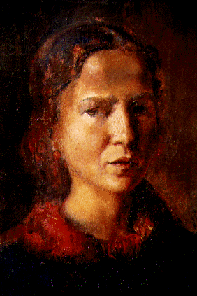Download free PDF books:
Clara Klinghoffer – The Girl Who Draws Like Raphael by her son, Michael J. Laurence.
Clara Klinghoffer – The Life and Career of a Traditional Artist by her husband, Joseph W.F. Stoppelman.
Clara Klinghoffer had her first one-woman exhibition of sixty works in London, 1919, when she was 19. The critics hailed her as “Masterly” - “…a dazzling radiance that has no equal at present in Pall Mall.” - “A revelation. That is the point of Clara Klinghoffer’s genius.” - “Her work shows the influence of Rembrandt and Hals.” - and the Daily Graphic hailed her debut with the headline, “Girl Who Draws Like Raphael – Success At 19". The review opened with: “Miss Clara Klinghoffer must be regarded as a new star. Her work is strongly individualistic and original, her point of view strictly her own, her power great. If she elects to do a thing it is done with masterful force.”
In 1925, the British journal Women of Today wrote: “A woman who became a famous painter overnight at the age of 19, Miss Clara Klinghoffer is holding her first one-man show (in) six years at the Redfern Gallery today. Now virtually recognized as one of the greatest English women painters, she was a poor and utterly unknown young girl from the East End when her first exhibition took the artistic world by storm in 1919.”
When Ms. Klinghoffer showed a talent for drawing at just 14, her parents were determined that she should have an opportunity to make something of it. Though poor, family funds were made available for art materials and for her to attend the John Cass Institute in Aldgate which she attended briefly. At 15, carrying a portfolio nearly as large as she, Clara visited London’s Central School of Arts & Crafts where, upon seeing her work, Bernard Meninsky commented, “Good Lord, that child draws like da Vinci.”
Invited to attend the Slade – but with the counsel that the teachers there would not be able to teach her anything more – she stayed for two years and won the admiration of Alfred Wolmark. He, and mentors such as Sir Jacob Epstein and Meninsky, recommended her to the Hampstead Gallery which unveiled her work in 1919. Her many press clippings and Reviews and the Museum collections worldwide which purchased her artwork, including the Tate Gallery and the National Portrait Gallery, document Clara's fame through the next 10 years in England and Europe. (Please see the "Review" section of this website .).
In 1927, she married Dutch journalist Joop Stoppelman and in 1929 moved to Holland with their daughter, Sonia. Clara's son, Michael, was born in Amsterdam. Despite a difficult husband's jealousy of her fame and family and the rising Nazi threat, she managed to combine raising a family with a career that had garnered acclaim throughout Europe.
In 1939, discovering Nazi spies had been planted in the household staff and aware that the invasion of Holland was imminent, the family returned to London briefly before departing for the United States. Before leaving Holland, their household furniture and some of her artwork were placed in storage in a Haarlem warehouse and subsequently stolen by the Nazis.
In 1945, following the war, Clara divided her time between her studios in London and New York. Although she had exhibited in the United States during the forties, fifties and sixties, she refused to join the abstract expressionism which had become so popular in America and her prominence was overshadowed by what she refered to as the splatter and drip approach to art.
In 1981, Terrence Mullaly, in the Daily Telegraph wrote, “…If ever there was an artist who for some time has been unjustly forgotten, it is Clara Klinghoffer … While the temporary eclipse of her reputation was not, given trends in the visual arts, surprising, it is certainly lamentable. She was a portrait painter of sensitive talent and, above all, a fine draughtsman …In her work her obvious sensitivity towards her sitters is manifested, and enforced by her ability not only to suggest weight and substance of a body, but also to convey mood … When much more celebrated artists are forgotten, she will be remembered.”
|
